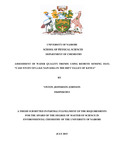Assessment Of Water Quality Trends Using Remote Sensing Data “Case Study Of Lake Naivasha In The Rift Valley Of Kenya
Abstract
This study was conducted using remote sensing data for the establishment of water quality trends
of Lake Naivasha from 2003 to 2011. Laboratory analysis was also conducted for three months
from September 2014 to November 2014 by collecting samples from six sampling points. These
sampling points were located using the Global Positioning System (GPS) for easy reference. The
results obtained from the remote sensing data were correlated with the laboratory analysis using
the Chi Square correlation method. Parameters analyzed by the remote sensing method included
total suspended matter(TSM), turbidity, coliform (chlorophyll a) and back scattering suspended
matters (conductivity). Water quality information was defined from Medium Resolution Imaging
Spectrometer (MERIS). Parameters analyzed insitu during the laboratory analysis were: pH,
temperature, turbidity, conductivity and dissolved oxygen. Parameters analyzed in the laboratory
were total suspended solid, total dissolved solid and coliform.
The study findings showed that the measurements conducted insitu on the lake for pH ranged
from 6.8 to 7.8. The temperature readings were ranging from 20.6OC to 24.7OC. The dissolved
oxygen levels were ranging from 4.53mg/l to 6.79mg/l.
The trends of the Total Suspended matter (TSM) from 2003 to 2011showed continuous rise and
fall with the highest level in November 2006 of 16.61mg/l and the lowest level in November
2011 of 4.27mg/l. The trend in turbidity level from 2003 to 2011 showed rise and fall in the
trends with the highest level in 2007 of 14.16FNU and the lowest value in 2011 of 2.31FNU. The
trends in the conductivity of the lake showed consistency for 2003, 2005 up to 2010 at the same
level of 0.3mg/l. In 2011 the reading was found to be 0.18mg/l and the lowest value recorded in
2004 of 0.15mg/l.
Parameters considered for correlation using the remote sensing data and the laboratory analysis
included TSS, turbidity and conductivity using the chi-square correlation coefficient. From the
three parameters correlated only turbidity showed a positive or direct correlation. The result from
the correlation coefficient was 0.916.
Publisher
University of Nairobi

